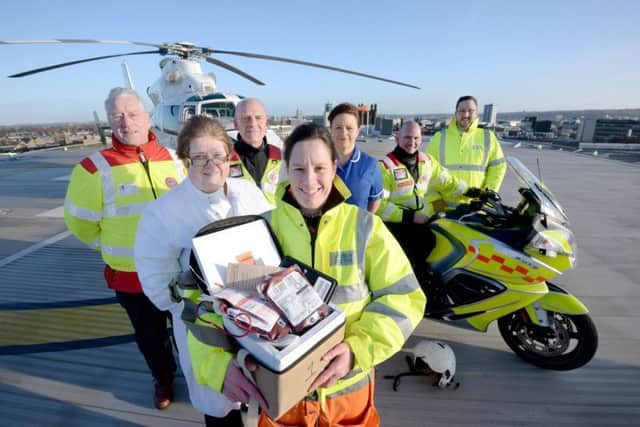'˜It makes a huge difference between life and death'


Neil Wilson, from Berwick and who works for the Glendale Gateway Trust in Wooler, suffered a severe head injury, collapsed lung, fractured pelvis and broken arm in the incident which happened as the car made a right turn at the junction of the B6354, near Ford, on September 30 last year. The Great North Air Ambulance Service (GNAAS) was called to the scene by road paramedics. The aircrew arrived and anaesthetised him before performing an advanced surgical procedure and administering two units of blood at the roadside.
The 46-year-old father-of-two, who is secretary at Berwick Wheelers Cycling Club, said: “The aircrew worked on me at the roadside for quite some time before I was ready to be flown to hospital.”
Advertisement
Hide AdAdvertisement
Hide AdOnce stabilised, he was transported to Newcastle’s Royal Victoria Infirmary (RVI) within 17 minutes where he arrived in a critical condition. He spent five weeks in hospital before being transferred to the Walkergate Park rehabilitation centre for a further two weeks.
Overall, roadside blood transfusions have helped to save 18 lives in the North East and Cumbria since the Blood on Board project launched just over a year ago. Air medics from the GNAAS have performed 60 blood transfusions, with a third of those deemed to have been of critical importance to survival.
The pioneering project is a collaboration between the Newcastle Hospitals, GNAAS and volunteers from Cumbria and Northumbria Blood Bikes. It was devised by Dr Rachel Hawes, consultant in anaesthesia and pre-hospital emergency medicine.
Neil said: “The fact that GNAAS now carries blood makes a huge difference between life and death. Paramedics who were first at the scene have told me that without the air ambulance I wouldn’t be where I am today. The outcome may well have been different.
Advertisement
Hide AdAdvertisement
Hide Ad“Although I still have a way to go, doctors expected my hospital stay to be far longer. They said if I wasn’t so fit, I might not have survived. It was a massive shock to all of my family, but they have been a huge support. It has been a lot for them to deal with.
“GNAAS is phenomenal and blood is such an important element to the work that they do. No matter how fast the helicopter can go, without blood, life may be lost. It is a huge asset.”
Neil recently handed over more than £1,700 to the charity that was raised by Berwick Wheelers Cycling Club.
This Saturday, he and some of the other patients who might well not have been here today without this service will meet clinical staff and volunteers from the organisations involved to celebrate the phenomenal recoveries they have made.
Advertisement
Hide AdAdvertisement
Hide AdBefore Blood on Board was introduced, patients would have to wait until they had been transferred to the nearest Major Trauma Centre for highly-specialist treatment. When heading to the RVI’s Great North Trauma and Emergency Centre, paramedics would call a dedicated Code Red hotline to alert the hospital trauma team of patients en-route with catastrophic bleeding injuries.
Blood on Board takes this approach one step further, with specially-prepared blood packs available for the air ambulance crews to take directly to the scene of an accident. This means that blood transfusions can be given almost immediately.